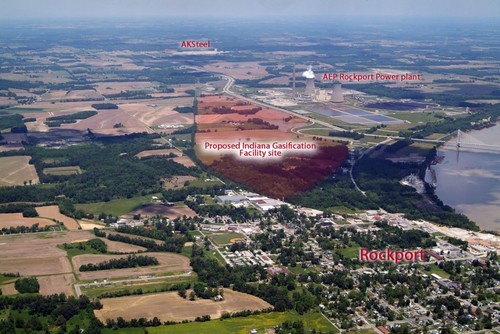Attending the Culver Duck Farm tour were (left to right): Ryan Clem, District Director for Congresswoman Jackie Walorski; Paul Lagemann, Regional Director for NE Indiana for US Senator Dan Coats; and Timothy Sanders, Associate Vice President for governmental relations for Purdue University.
Unfortunately, no members of the Indiana General Assembly participated in this program since the tour was held during the final week of the 2013 session. Another program for Indiana state legislators is clearly in order.
On 4/23/2013, the Indiana Biomass Energy Working Group (IBEWG), met at Das Dutchman Essenhaus in Middlebury, IN, to learn about the Culver Duck anaerobic digester that sells power power to NIPSCO using their voluntary feed-in tariff (VFIT).
This was a terrific program, tour and networking opportunity. Sorry if you missed it. This was definitely worth the long drive from Indianapolis to Middlebury.
This project was made possible in part by participation in the voluntary feed-in tariff (VFIT) offered by Northern Indiana Public Service Company (NIPSCO). For more information about this program contact: Laura.Arnold@IndianaDG.net or call (317) 635-1701. This program is scheduled to expire 12/31/2013, however, discussions are scheduled soon to determine whether this program will be continued. Join IndianaDG to learn more and to participate in this discussion. If discussions are positive, we expect that NIPSCO will file a petition with the Indiana Utility Regulatory Commission (IURC) before the end of the year.
Presentations from the meeting are available on-line at:
http://extension.purdue.edu/
In particular, you may be interested in the slides presented by Dee Cota with NIPSCO:
http://extension.purdue.edu/renewable-energy/pdf/NIPSCO_Feed_In_Tariff_-_Dee_Cota_April_23.pdf
Find additional information at: http://www.jpr1source.com/culver-duck/
Watch this JPR video it's awesome: http://youtu.be/nhcMX5LH52I
Way to go Culver Duck and JPR!
|
IBEWG April 23, 2013 Apr 26, 2013 |

Jen Meier | The Goshen News Culver Duck Renewable Resource Manager Don Young stands in front of the digester and three massive generators that turn duck waste into energy. The process began in 2011 with the installation of wetlands and was completed in December 2012 with a $6 million digester system. Jennifer Meier
April 28, 2013
Culver Duck factory turns waste into energy
By JENNIFER MEIER THE GOSHEN NEWS
MIDDLEBURY — When it comes to renewable energy, Culver Duck of Middlebury has, well — all its ducks in a row.
Beginning with a 10-acre wetlands project in 2011, the duck-processing company has embarked on a $6 million journey to become a zero discharge plant by utilizing duck waste to generate methane gas to power the plant.
In March of 2012 construction began on a 930,000-gallon digester, 58,000-gallon reception pit, control room, pump room, separator and biofiber storage building and three large generators.
By December of last year, the anaerobic (absence of oxygen) duck waste digester was up and running.
“We aren’t up to full capacity yet,” said Culver Duck’s Renewable Resource Manager Don Young. “We are continually improving on the amount of gas produced and gas quality. We are almost there.”
How it’s done
The process begins with the plant’s duck waste, called offal, and waste water. The offal heads to the digester and the waste water is pumped into the reception pit. There the concoction is mixed by an agitator with vegetable by-products like corn husks and damaged potatoes.
That mix is then pumped into the digester where three agitators combine it and the offal. The methane gas created is then used to power three massive 550 horse power generators.
“We sell the energy to NIPSCO and then buy it back,” Young said. “The arrangement will meet all the plant’s needs as well as an additional 60 to 120 homes.”
But there’s more to the process than just converting methane into energy.
“If I am pumping something into the digester, I have to pump something out,” Young said. “What’s left goes to the separator room.”
The offal mixture is separated into solids and liquids. The liquid waste is filtered through the wetlands and the solid waste becomes biofibers — which is good for soil enhancement.
And the extra heat exhaust created by the chemical process in the digester will be used to help supplement the plant’s heating needs.
According to company officials, Culver Duck’s $6 million investment will pay for itself in four to five years.
Culver Duck is one of 12 facilities using anaerobic digester systems in the state. Nine of those digesters are being operated at commercial livestock farms.
“This really is cutting-edge technology,” Young said. “I believe we are the only plant in the Western Hemisphere dealing with duck offal.”
The process and the plant were the focus of the Indiana Biomass Energy Working Group’s spring session on Tuesday. The event hosted by Purdue University, pulled together industry experts, researchers, members of the finance community, government officials, farmers and interested members of the public from all over the state.
The group, along with Culver Duck management, met at Das Dutchmen Essanhaus in Middlebury for presentations that included digester technology, Culver Duck’s journey from start to finish, and understanding the NIPSCO energy buying process.
The day’s sessions ended with a tour of the Culver Duck anaerobic digester system.
“This was the largest group we’ve had tour yet,” Young said. “And it went very well. They were very curious and had a lot of questions.”
Others notice
Chad Martin, a renewable energy specialist from the agricultural and biology department at Purdue University, was a part of Tuesday’s program.
“This is not only a great example of solving problems, but of creating opportunities. They are managing waste materials and creating clean renewable energy,” Martin said. “This is definitely a good thing for finding other livestock opportunities statewide.”
Anaerobic Digestion Specialist and researcher at Purdue University Dr. Jiqin Ni, liked what he saw at Culver Duck.
“This is very impressive. They are producing clean, renewable energy, reducing pollution and reducing our dependence on fossil fuels,” Dr. Ni said. “Technology in this area is really growing.”
The technological advances have made it possible for the entire digester process at Culver Duck to be a one-man operation.
“I’ve had plenty of help from IT guys and consultants,” Young said. “But once all the details have been worked out, this really is a one-person job.”
In fact when the working day is over, Young can start and stop the process, check the temperature in the digester, and know how many kilowatts the generators are putting out from his laptop computer at home.
On Friday the Culver Duck Mascot will join the Silver Hawks Mascot on the field during the game against the Quad Cities at Coveliski Stadium in South Bend. The green duck mascot is sponsored by Culver Duck, Whole Foods in Mishawaka (where duck from Culver Duck can be purchased) and JPR consulting firm.
Culver Duck opened in Middlebury in 1960 and raises and processes 5 million ducks a year.
P.S. I joined this group Friday evening at Coveliski Stadium in South Bend and enjoyed a great baseball game while eating a scrumptious dinner featuring duck from Culver Farm. Thanks again for inviting me. Laura Ann Arnold






